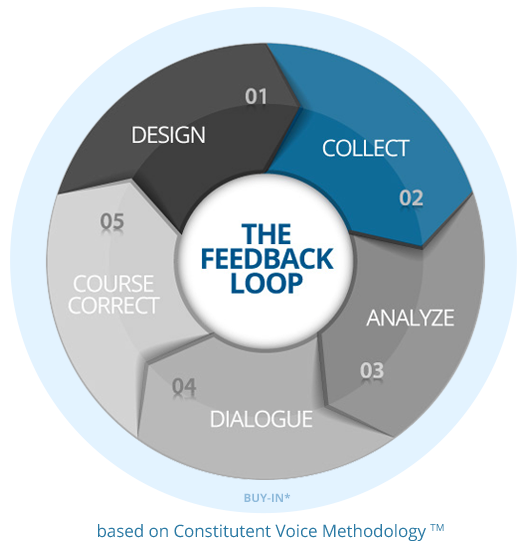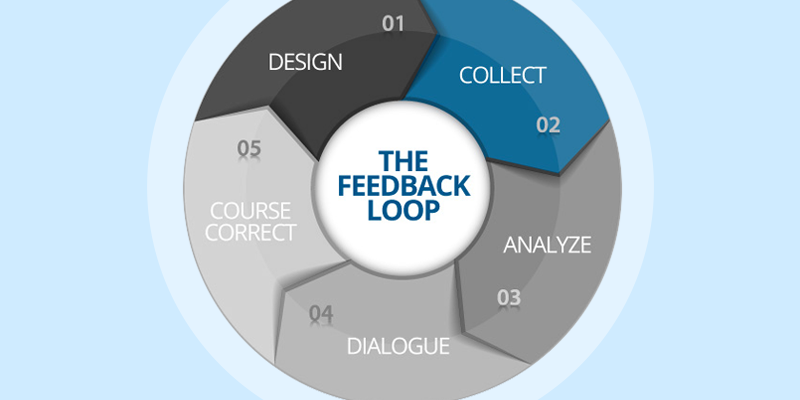
Welcome to Feedback Fundamentals. In this series, we’ll be getting back to the basics and highlighting what it means to “close the loop.” Whether you’re well versed in the jargon or new to the feedback community, this series will introduce you to ideas, frameworks, tools and approaches that we believe are essential for a strong feedback practice. Feedback Fundamentals is all about building a strong foundation and realizing a vision of listening to the people you seek to serve.

Last time, we examined design – the step in which you plan the rest of your feedback loop. This week, we examine the Collect step.
When you get to the collect step of a feedback loop it can feel like the rubber is really hitting the road. After all, this is the step in which you actually ask for feedback! What feedback questions are you going to ask? When and where are you going to ask them? How are you going to receive the answers? These questions are at the heart of the Collect step.
The good news is that there are many resources to help you think about how to collect feedback. Some resources focus on how to ask for feedback in a way that encourages responses and ongoing conversation. Sometimes open-ended questions will be the best way to elicit meaningful and honest feedback. Sometimes yes-no questions, or those that ask for a rating on a scale are the best way to collect feedback that you can use.
Keep it simple.
One popular way of framing a feedback question is the Net Promoter Score. Net Promoter has shown to be very effective in the for-profit sector for both high response rates and facilitation of customer segmentation and feedback analysis. Whether you choose to use the traditional wording, or create a question tailored to your feedback loop needs, simple surveys like the NPS make it more likely that your target audience will respond. Many Feedback Labs members have shared their experiences and lessons learned using the Net Promoter Score.
Collect feedback during high response timeframes.
Other resources help you think about when and where to collect feedback. When and where are people most likely to give you honest and meaningful feedback? One tip from the Center for Employment Opportunities is to focus on ‘moments of truth’ when feedback is top of mind for the person you’re seeking to serve, and they are most likely to share honest feedback. The Kuja Kuja project in Uganda, designed by IDEO.org and the American Refugee Committee enables refugees to give feedback right when they access water services.
Use the right technology
Still other resources focus on how to collect the answers you receive to your feedback questions. You might use emails, websites, SMS, automated phone calls, individual interviews, or physical comment boxes with good old pen and paper. Check out the Feedback Labs toolkit for suggestions of tools you can use!
Technology is never a silver bullet, but it can hugely enable the collection of feedback. A study by VOTO Mobile and the Center for Global Development found that automated SMS and voice calls can support faster and cheaper feedback collection in even very poor countries. At the same time, low-tech and interpersonal methods are sometimes most appropriate. If you are using digital technology, make sure your feedback needs are driving your use of technology, not the other way around!
Only collect what you need
A common pitfall of the Collect step is attempting to collect too much feedback. It can be tempting to collect lots of data and then figure out what is most useful. But this can lead to the people from whom you’re collecting feedback getting tired of answering questions. Just because you can collect a lot of data doesn’t mean you should. Be focused and guided by the decisions you made in the Design step!
It is also important to think about the privacy and security of the data you collect. Often, feedback can contain sensitive information. Allowing for confidential or anonymous responses can be important, but be aware that with so many organizations collecting information, data we think is anonymous may become identifiable when combined with other sets of data. Check out these resources on how to think about ethical use of data and mitigating risks to protect the interests and safety of the people from whom you are collecting feedback.
Making choices about what questions to ask, when and where to ask them, and how to collect and store the answers you receive are why the Buy-in and Design steps that come first in the feedback loop are so important.
In the buy-in step, you thought through what information you and other stakeholders need to make decisions and support the feedback process. That should guide what feedback questions you ask. In the design step, you iterated on the wording of the questions you’ll ask, when and where you’ll ask them and on your plans for collecting and storing the answers. By the time you reach the collect step, you should feel very prepared!
Thanks for reading! Please share with your networks, and tell us how we can improve this series. Next month, tune in as we explore the wild and wonderful world of feedback analysis.







